The October 22 VC games include Lunar Pool (NES); Ninja Jaja Maru Kun (NES/Famicom); and Golden Axe 3 (Genesis/Mega Drive). On first glance, this would appear to be a disappointing week. And for the most part, you'd be right. But if you stick with it and muscle your way through, you'll find one hidden gem in the muck. Three guesses which one that is. Yadda yadda. This entire post has taken most of the week to write, mainly because of access to the computer, but I'm glad to see it finished. Screenshots are a pain; most likely the fault of Internet Explorer, which no sentient being should ever use. Cough, Firefox, cough. Let's get to the games...
+%5B!%5D_001.jpg)
+%5B!%5D_002.jpg) Lunar Pool - Compile for NES - 3/10
Lunar Pool - Compile for NES - 3/10Compile, one of the true classic development houses, churned out numerous shoot-em-ups over the years, and are probably best known for creating the Puyo Puyo series of puzzlers. They also were responsible for this little-seen NES game, published by Pony Canyon in Japan and FCI in North America. It's a videogame version of billiards. It sucks.
Alright, I should probably go into more detail. There really isn't much point. There has always been a pecking order as far as game publishers are concerned. Still is. Back in the Nintendo days, the top dogs were Konami, Capcom, Tecmo, and Nintendo themselves. FCI and Pony Canyon were pushing the table scraps. These were the sorry videogames that clueless parents and relatives would buy for you as Christmas presents. You'd open the package, knowing that it was a Nintendo game just because of the box, and it would turn out to be something like Super Pitfall or Lunar Pool. It's like being handed a can of lima beans. And then being told that your Christmas present is also your birthday present, since they're so close together. Hmph. Thanks, Santa. Jerk.
I've always wondered why certain videogames ever get made. These are the pointless games, the ones that simulate, for a premium price, something that you could do, just as easily, for free or a handful of coins. Did some dimwit actually try to make a game out of Hide-and-Seek? Or Tarot cards? Or board games? What dumb schmuck would play a video board game? There's a whole closet full of 'em, and nobody you knew ever wanted to touch them, apart from Monopoly or Checkers. Or maybe Risk, if you're the kind to go through that teenage boy Risk phase. Teaches you the valuable lesson of never-ending wars and pointless stalemates.
So what's the point in making a video pool game? Really, what's the use? I never paid more than a buck to play on a real pool table, with real balls and a real cue stick. Most times I'd play for free. My current apartment has two tables. Why would I try some simple-minded, scaled down computer hack job? Why would I spend five bucks for the experience of feeling ripped off and bored? I already had that experience. I went to college.
To be fair, Lunar Pool at least is competent, which means that you can hit the balls and expect them to skittle off in the right direction. There are a number of strange, oddball tables, which appear to be challenging but somehow end up being embarassingly easy. I think I cleared two or three boards on my first try. No missed shots.
What the heck is this doing on the Virtual Console? There are hundreds of titles to choose from in the NES library. It remains one of the greatest game consoles ever made. Why are all the lousy games getting released? Who's in charge of quality control here?!
_001.jpg) Ninja JaJa Maru Kun - Jaleco for Famicom (NES) - 2/10
Ninja JaJa Maru Kun - Jaleco for Famicom (NES) - 2/10Alright, folks, here's what you need to do. Just copy everything I wrote about Lunar Pool, then paste it here, and translate it into Japanese. Add swear words where necessary. There's your damned review. What a sorry sack of crap. LSD and magic mushrooms remain illegal in this country, but this game is perfectly acceptable. Which one do you think will cause more brain damage? That's justice for you. Better yet, skip the drugs. I'll just hit my head against a wall a few times, until the room starts spinning. Yeah, that's still much better. Better than the drugs and better than this game.
Ninja Jaja Maru Kun is a Japanese title, originally appearing on the Famicom in 1985. It never saw a release Stateside. Back then, Nintendo had this thing called a "seal of quality." They actually vetted games pretty strictly before giving them the green light in America. They understood the collapse of the game market in 1983 and 1984, understood it all too well. Games like Super Mario Brothers and The Legend of Zelda would become the new standard for games. Jaja Maru would become fodder for firecrackers and termites.
This game is shit. No, seriously. The name of the game, when properly translated into English, reads as follows: "This Game is Shit."
Hmm...okay, here is the point to the game. You play a ninja who runs across a multi-tiered stage and shoots enemies who bob up and down and wander aimlessly for no reason. It's much like swatting flies. It's roots probably lie in early arcade games like Space Panic, and maybe Defender; I am reminded a little of a Broderbund computer game called Drol, which was kind of like Defender on very strange drugs. Don't ask me which kind.
Drol was actually somewhat interesting, especially for its time. It carried a certain darly surreal style, with bizarre buglike creatures and droning, atonal sound effects. You played a strange-looking animal equipped with a ray gun and a backpack, and worked your way around until you found runaway characters. Eventually, you faced the main villain, some sort of creepy masked medicine man. There was something of William Burroughs in that game.
Jaja Maru is nothing like that. It's more like a stale sandwich, or staring at wallpaper. It's a sorry excuse for a game, like most of those early Famicom and NES titles. I don't think a game like this was ever appealing. You could make the nostalgia excuse for a game this old; but I can't imagine anyone believing you with a straight face. What would be the point? What could you brag about, in proving that you could muster the basic primate reflexes to waltz through this slow sludge of sorry syrup? And then Nintendo goes the extra mile, and charges you six bucks for your efforts. That's one dollar more than domestic NES games. You know, real classics like Urban Champion and Lunar Pool and Tennis.
In a more enlightened society, this would qualify as a mugging.



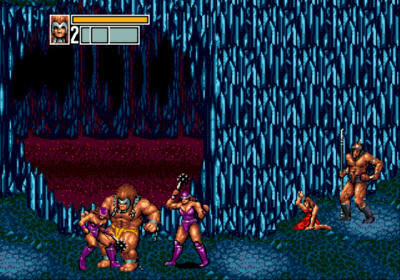
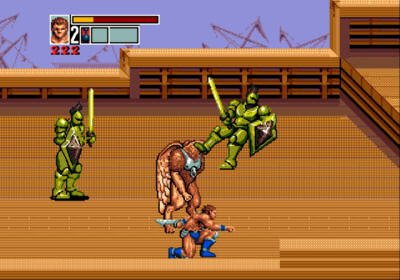
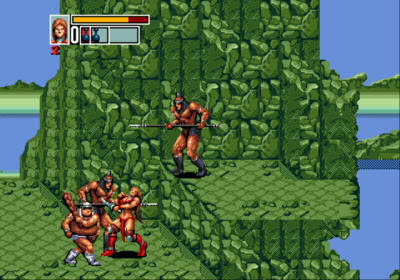



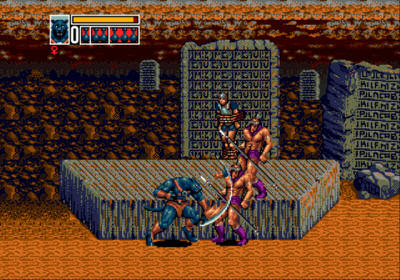
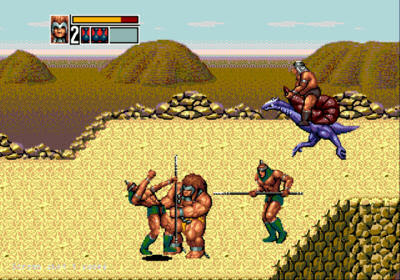 Golden Axe 3 - Sega for Mega Drive (Genesis) - 8/10
Golden Axe 3 - Sega for Mega Drive (Genesis) - 8/10Hmm....I still don't have any idea what to say about this game. Even with an extra day or two to throw some thoughts together. Let's just jump into the mosh pit and see what breaks, shall we?
Ow! My leg's gone. Again. Just great. Don't let anyone fool you about aging gracefully, kids. Everything breaks down, and it royally sucks.
Okay, Golden Axe 3. The third and final installment on the Sega Mega Drive, which however failed to make its way out of Japan. It became one of the great, "lost" Sega games to the rest of us in the West. We were assured by the powers that be - namely, the nerds in charge of the prozines and the suits at Sega themselves - that we weren't missing a thing, that the game was really a bust. They were wrong. They were probably jealous, too, jealous of missing out.
Perhaps everyone was already burned out by then, burned out on the endless assault of scrolling beat-em-ups like Double Dragon and Final Fight and Streets of Rage and a thousand other faceless photocopies. Certainly by 1993 you had your button-mashing kung-fu fix.
Here's how these sort of games work. You play a character, usually some sort of steroid freak, or some hot chick who can fight while barely dressed, or some even bigger steroid freak. You walk down a city street, find some goon - let's call him Lenny. You're always on a first-name basis with these guys, which is nice because you're going to be fighting them at least five hundred times over the course of the game. The street gangs they belong to are very small, only a handful of members. They all have to shuffle in and out to present the illusion that they're much bigger than they are. Sometimes they'll even change colors to trip you up. Look out, Bigger Steroid Dude! Lenny is back, and this time he's painted blue! And now he's green, or charcoal, or is that mauve? What the hell is "mauve," anyway?
So you see Lenny, then proceed to punch and kick him into traction, by complex use of the attack button. It goes like this. You hit the attack button, then you hit it again. Then you hit it again, and maybe twice more for good measure. Whew. That was hard. Right up there with quantum mechanics. Max Planck would have his hands full with any one of these games.
Which brings us back to Sega's old Golden Axe series. The first game was an arcade hit, one of those games designed to steal your quarters every couple of minutes. It was a pretty good way to spend your time and money before you discovered girls. It was also helpful when those girls wouldn't discover you back. Great stress reliever. Hmm. Now that I think about it, this probably is the whole reason for the martial-arts fighting game to exist. Better to take that frustration out on the bad guys in Golden Axe. Also, you get to look at a hot girl's butt, which is more than you're gonna see as long as you're in high school, kid. Just deal with it.
The arcade game was an early release for the Sega Genesis, and a standout hit, thanks to its large charaters and detailed graphics. A sequel arrived in the arcades, but nobody bothered to pay any attention to it. You're better off ignoring that one, too. It wasn't worth much. You got to play as a scrawny little kid with bad hair. I didn't need to role-play that part. I already was a scrawny little kid with bad hair. Just look at my yearbook.
A sequel, Golden Axe 2, arrived on the Genesis as an exclusive. Either everybody noticed that it was essentially the exact same game as before, no nobody noticed. Either way it didn't matter. It was a good game and another quality time-waster; it didn't have an original thought in its pretty little head, but it was faster and more responsive than the original.
A year or two passed and Golden Axe 3 finally arrived for the Mega Drive in Japan. By then, the series had been lapped several times by the Streets of Rage series, as well as the tournament fighters that followed Street Fighter 2. The whole notion of Governor Ahnold hack-and-slash seemed passe, out of date, worn out. But, to be fair, we were all tired of the whole ball of wax by '93. For one thing, we were finally out of high school and into college. And secondly, and more importantly, we were all getting steady dates. So no more needless frustration to vent.
It probably required some space of years to put between ourselves and the Genesis, to forget about most of those cheap, pointless brawlers, and also to finally appreciate the good ones. Golden Axe 3 got a bad rap. It really is one of the good ones.
In fact, it might even be the best of the three titles. That's despite its best efforts to ruin itself. The game was strapped with a tiny memory space - 4 megabits, or 512K - while most top-priority Sega games were allocated many times more. That's closer to the size of the earlier Genesis games, like Revenge of Shinobi or Last Battle or Ghouls 'N Ghosts or Thunder Force 2. Standard Genesis games hovered between 16 and 32 megabits. Those sizes were necessary to keep up with the competition, and push the envelope.
Golden Axe 3 appears scraggy and grungy. It is also rather impressive with its graphics. The visual style is closer to that late-NES period, with heavy use of tiles and rough patterns. It makes for some impressive environments, through caves, across mountains, and through towns and castles. There's even a pirate ship sailing somewhere, and a giant soaring eagle. This game possesses a quality that is revealed slowly, over time. You have to battle your way across much of the countryside to seriously appreciate it all. If this were released in, say, 1990, it would have been hailed as a triumph.
One thing that always bothered me about Golden Axe - more than most other brawlers - was its slow, lethargic pace. This slower action carried well in the aracdes, because the game heavily relied upon smooth animation. The Genesis port needed to cut some of the in-between movements out, and the result was something a little choppier and sluggish. Golden Axe 2 worked to fix this, but it was still bound by that feel. Sega probably thought that slow half-step-behind pace was part of the charm. I have no idea what they were thinking.
For Golden Axe 3, the influence of the tournament fighters was far more evident. Like Bare Knuckle 3 (the less said of Sega of America's sorry hack-up of Streets of Rage 3 said, the better), the cast of characters was empowered with a far larger array of moves. It was always a pretty basic fighter, but now the offense really opens up. There are different canned combos depending on your distance to your opponent, and the special magic attacks - Golden Axe's great iconic landmark - are bigger and meaner than ever. Somehow, Sega snuck in some desperately-needed special effect for this part, especially Axe Battler's whirlwind and Tyrus' flames. Two players can team up and combine their magic, which is really clever. It's a fun way to get you to mix and match all four of the fighters around, just to see all the cool moves.
I think this game owes a debt to Virtua Fighter. Wouldn't even be surprised if members of Sega's VF team were involved in the production. The movements are precise, very demanding, almost anal. Which is exactly like the first Virtua Fighter. The idea is to keep the joystick or joypad neutral, and then move for specific attacks, instead of merely marching forward and mashing the "B" button.
You shouldn't be surprised to see that your fighters can block attacks, and that this is an essential skill. You really won't get very far with the old attack-attack-attack approach. Each confrontation is a challenge, a real fight for once. Some bouts against two or three enemies - the skeletons are the worst, but don't count out those knights - can slog on and on. It's more like one of the old Ali-Frazier match-ups than a typical video fighting game. I think this is also a key reason why I like this Golden Axe the best. It's the most challenging. It's an expert's game, a thinking game.
There are a number of multiple paths you can take, so it's impossible to play the same game twice. There are sometimes even multiple paths in the same town, or different sets of stairs on the boat. Occasionally you'll even find hostages who can be rescued, which is a nice touch. It all adds to the atmosphere, of which this game has in spades.
Many critics tend to think of Virtual Console as a throwaway, a place for old games that aren't worth more than a few minutes' time, and then only for nostalgia. We've already seen several examples that proves this idea wrong. Gamers want their hobby to be taken seriously, to be declared "art." Well, kids, there's no art without history, and as long as videogames are treated as instantly-desposable commodoties, you'll get no respect.
There, I'm done! If anybody needs me, I'll be in the den listening to Hendrix.
No comments:
Post a Comment